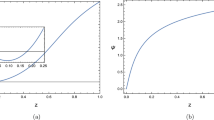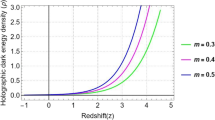Abstract
We employ holographic techniques to study quantum quenches at finite temperature, where the quenches involve varying the coupling of the boundary theory to a relevant operator with an arbitrary conformal dimension 2 ≤ Δ ≤ 4. The dual bulk theory is five-dimensional Einstein gravity with negative cosmological constant coupled to a massive real scalar and our calculations are perturbative in the amplitude of the bulk scalar. The evolution of the system is studied by evaluating the expectation value of the quenched operator and the stress tensor throughout the process. The time dependence of the new coupling is characterized by a fixed timescale and the response of the observables depends on the ratio of the this timescale to the initial temperature. The observables exhibit universal scaling behaviours when the transitions are either fast or slow, i.e., when this ratio is very small or very large. The scaling exponents are smooth functions of the operator dimension. We find that in fast quenches, the relaxation time is set by the thermal timescale regardless of the operator dimension or the precise quenching rate.
Similar content being viewed by others
References
S. Mondal, D. Sen and K. Sengupta, Non-equilibrium dynamics of quantum systems: order parameter evolution, defect generation, and qubit transfer, Quantum Quenching, Anealing and Computation, Lect. Notes Phys. 802 (2010) 21 [arXiv:0908.2922].
J. Dziarmaga, Dynamics of a quantum phase transition and relaxation to a steady state, Adv. Phys. 59 (2010) 1063 [arXiv:0912.4034].
A. Polkovnikov, K. Sengupta, A. Silva and M. Vengalattore, Nonequilibrium dynamics of closed interacting quantum systems, Rev. Mod. Phys. 83 (2011) 863 [arXiv:1007.5331] [INSPIRE].
A. Lamacraft and J. Moore, Potential insights into non-equilibrium behavior from atomic physics, chapter forthcoming in Ultracold Bosonic and Fermionic Gases, A. Fletcher, K. Levin and D. Stamper-Kurn eds., Contemporary Concepts in Condensed Matter Science, Elsevier, The Netherlands (2012) [arXiv:1106.3567].
L.D. Landau and E.M. Lifshitz, Quantum mechanics, Course of Theoretical Physics, Volume 3, (1989).
P. Calabrese and J.L. Cardy, Evolution of entanglement entropy in one-dimensional systems, J. Stat. Mech. 04 (2005) P04010 [cond-mat/0503393] [INSPIRE].
P. Calabrese and J.L. Cardy, Time-dependence of correlation functions following a quantum quench, Phys. Rev. Lett. 96 (2006) 136801 [cond-mat/0601225] [INSPIRE].
P. Calabrese and J. Cardy, Quantum quenches in extended systems, J. Stat. Mech. 06 (2007) P06008 [arXiv:0704.1880] [INSPIRE].
S. Sotiriadis and J. Cardy, Quantum quench in interacting field theory: a self-consistent approximation, Phys. Rev. B 81 (2010) 134305 [arXiv:1002.0167] [INSPIRE].
S. Sotiriadis and J. Cardy, Inhomogeneous quantum quenches, J. Stat. Mech. 11 (2008) P11003 [arXiv:0808.0116].
S. Sotiriadis, P. Calabrese and J. Cardy, Quantum quench from a thermal initial state, EPL 87 (2009) 20002 [arXiv:0903.0895].
M. Rigol, V. Dunjko, V. Yurovsky and M. Olshanii, Relaxation in a completely integrable many-body quantum system: an ab initio study of the dynamics of the highly excited states of lattice hard-core bosons, Phys. Rev. Lett. 98 (2006) 050405.
C. Kollath, A.M. Läuchli and E. Altman, Quench dynamics and nonequilibrium phase diagram of the Bose-Hubbard model, Phys. Rev. Lett. 98 (2007) 180601 [cond-mat/0607235].
S.R. Manmana, S. Wessel, R.M. Noack and A. Muramatsu, Strongly correlated fermions after a quantum quench, Phys. Rev. Lett. 98 (2007) 210405 [cond-mat/0612030].
L.-Y. Hung, M. Smolkin and E. Sorkin, Modification of late time phase structure by quantum quenches, Phys. Rev. Lett. 109 (2012) 155702 [arXiv:1206.2685] [INSPIRE].
J.M. Maldacena, The large-N limit of superconformal field theories and supergravity, Adv. Theor. Math. Phys. 2 (1998) 231 [Int. J. Theor. Phys. 38 (1999) 1113] [hep-th/9711200] [INSPIRE].
O. Aharony, S.S. Gubser, J.M. Maldacena, H. Ooguri and Y. Oz, Large-N field theories, string theory and gravity, Phys. Rept. 323 (2000) 183 [hep-th/9905111] [INSPIRE].
S.R. Das, T. Nishioka and T. Takayanagi, Probe branes, time-dependent couplings and thermalization in AdS/CFT, JHEP 07 (2010) 071 [arXiv:1005.3348] [INSPIRE].
P. Basu and S.R. Das, Quantum quench across a holographic critical point, JHEP 01 (2012) 103 [arXiv:1109.3909] [INSPIRE].
S.R. Das, Holographic quantum quench, J. Phys. Conf. Ser. 343 (2012) 012027 [arXiv:1111.7275] [INSPIRE].
P. Basu, D. Das, S.R. Das and T. Nishioka, Quantum quench across a zero temperature holographic superfluid transition, JHEP 03 (2013) 146 [arXiv:1211.7076] [INSPIRE].
U.H. Danielsson, E. Keski-Vakkuri and M. Kruczenski, Spherically collapsing matter in AdS, holography and shellons, Nucl. Phys. B 563 (1999) 279 [hep-th/9905227] [INSPIRE].
U.H. Danielsson, E. Keski-Vakkuri and M. Kruczenski, Black hole formation in AdS and thermalization on the boundary, JHEP 02 (2000) 039 [hep-th/9912209] [INSPIRE].
S.B. Giddings and S.F. Ross, D3-brane shells to black branes on the Coulomb branch, Phys. Rev. D 61 (2000) 024036 [hep-th/9907204] [INSPIRE].
S.B. Giddings and A. Nudelman, Gravitational collapse and its boundary description in AdS, JHEP 02 (2002) 003 [hep-th/0112099] [INSPIRE].
S. Bhattacharyya and S. Minwalla, Weak field black hole formation in asymptotically AdS spacetimes, JHEP 09 (2009) 034 [arXiv:0904.0464] [INSPIRE].
R.A. Janik and R.B. Peschanski, Gauge/gravity duality and thermalization of a boost-invariant perfect fluid, Phys. Rev. D 74 (2006) 046007 [hep-th/0606149] [INSPIRE].
R.A. Janik, Viscous plasma evolution from gravity using AdS/CFT, Phys. Rev. Lett. 98 (2007) 022302 [hep-th/0610144] [INSPIRE].
S. Lin and E. Shuryak, Toward the AdS/CFT gravity dual for high energy collisions. 3. Gravitationally collapsing shell and quasiequilibrium, Phys. Rev. D 78 (2008) 125018 [arXiv:0808.0910] [INSPIRE].
J. Abajo-Arrastia, J. Aparicio and E. Lopez, Holographic evolution of entanglement entropy, JHEP 11 (2010) 149 [arXiv:1006.4090] [INSPIRE].
T. Albash and C.V. Johnson, Evolution of holographic entanglement entropy after thermal and electromagnetic quenches, New J. Phys. 13 (2011) 045017 [arXiv:1008.3027] [INSPIRE].
H. Ebrahim and M. Headrick, Instantaneous thermalization in holographic plasmas, arXiv:1010.5443 [INSPIRE].
V. Balasubramanian et al., Thermalization of strongly coupled field theories, Phys. Rev. Lett. 106 (2011) 191601 [arXiv:1012.4753] [INSPIRE].
V. Balasubramanian et al., Holographic thermalization, Phys. Rev. D 84 (2011) 026010 [arXiv:1103.2683] [INSPIRE].
V. Balasubramanian, A. Bernamonti, N. Copland, B. Craps and F. Galli, Thermalization of mutual and tripartite information in strongly coupled two dimensional conformal field theories, Phys. Rev. D 84 (2011) 105017 [arXiv:1110.0488] [INSPIRE].
J. Aparicio and E. Lopez, Evolution of two-point functions from holography, JHEP 12 (2011) 082 [arXiv:1109.3571] [INSPIRE].
A. Allais and E. Tonni, Holographic evolution of the mutual information, JHEP 01 (2012) 102 [arXiv:1110.1607] [INSPIRE].
V. Keranen, E. Keski-Vakkuri and L. Thorlacius, Thermalization and entanglement following a non-relativistic holographic quench, Phys. Rev. D 85 (2012) 026005 [arXiv:1110.5035] [INSPIRE].
D. Galante and M. Schvellinger, Thermalization with a chemical potential from AdS spaces, JHEP 07 (2012) 096 [arXiv:1205.1548] [INSPIRE].
E. Caceres and A. Kundu, Holographic thermalization with chemical potential, JHEP 09 (2012) 055 [arXiv:1205.2354] [INSPIRE].
I.Y. Arefeva and I. Volovich, On holographic thermalization and dethermalization of quark-gluon plasma, arXiv:1211.6041 [INSPIRE].
W. Baron, D. Galante and M. Schvellinger, Dynamics of holographic thermalization, JHEP 03 (2013) 070 [arXiv:1212.5234] [INSPIRE].
P.M. Chesler and L.G. Yaffe, Horizon formation and far-from-equilibrium isotropization in supersymmetric Yang-Mills plasma, Phys. Rev. Lett. 102 (2009) 211601 [arXiv:0812.2053] [INSPIRE].
P.M. Chesler and L.G. Yaffe, Boost invariant flow, black hole formation and far-from-equilibrium dynamics in N = 4 supersymmetric Yang-Mills theory, Phys. Rev. D 82 (2010) 026006 [arXiv:0906.4426] [INSPIRE].
D. Garfinkle and L.A. Pando Zayas, Rapid thermalization in field theory from gravitational collapse, Phys. Rev. D 84 (2011) 066006 [arXiv:1106.2339] [INSPIRE].
D. Garfinkle, L.A. Pando Zayas and D. Reichmann, On field theory thermalization from gravitational collapse, JHEP 02 (2012) 119 [arXiv:1110.5823] [INSPIRE].
H. Bantilan, F. Pretorius and S.S. Gubser, Simulation of asymptotically AdS 5 spacetimes with a generalized harmonic evolution scheme, Phys. Rev. D 85 (2012) 084038 [arXiv:1201.2132] [INSPIRE].
M.P. Heller, D. Mateos, W. van der Schee and D. Trancanelli, Strong coupling isotropization of non-Abelian plasmas simplified, Phys. Rev. Lett. 108 (2012) 191601 [arXiv:1202.0981] [INSPIRE].
M.P. Heller, R.A. Janik and P. Witaszczyk, A numerical relativity approach to the initial value problem in asymptotically anti-de Sitter spacetime for plasma thermalization — an ADM formulation, Phys. Rev. D 85 (2012) 126002 [arXiv:1203.0755] [INSPIRE].
M. Bhaseen, J.P. Gauntlett, B. Simons, J. Sonner and T. Wiseman, Holographic superfluids and the dynamics of symmetry breaking, Phys. Rev. Lett. 110 (2013) 015301 [arXiv:1207.4194] [INSPIRE].
B. Wu, On holographic thermalization and gravitational collapse of massless scalar fields, JHEP 10 (2012) 133 [arXiv:1208.1393] [INSPIRE].
B. Wu, On holographic thermalization and gravitational collapse of tachyonic scalar fields, JHEP 04 (2013) 044 [arXiv:1301.3796] [INSPIRE].
V. Cardoso et al., NR/HEP: roadmap for the future, Class. Quant. Grav. 29 (2012) 244001 [arXiv:1201.5118] [INSPIRE].
A. Buchel, L. Lehner and R.C. Myers, Thermal quenches in N = 2∗ plasmas, JHEP 08 (2012) 049 [arXiv:1206.6785] [INSPIRE].
E. Witten, Anti-de Sitter space, thermal phase transition and confinement in gauge theories, Adv. Theor. Math. Phys. 2 (1998) 505 [hep-th/9803131] [INSPIRE].
S. Gubser, I.R. Klebanov and A.M. Polyakov, Gauge theory correlators from noncritical string theory, Phys. Lett. B 428 (1998) 105 [hep-th/9802109] [INSPIRE].
E. Witten, Anti-de Sitter space and holography, Adv. Theor. Math. Phys. 2 (1998) 253 [hep-th/9802150] [INSPIRE].
P. Breitenlohner and D.Z. Freedman, Positive energy in anti-de Sitter backgrounds and gauged extended supergravity, Phys. Lett. B 115 (1982) 197 [INSPIRE].
P. Breitenlohner and D.Z. Freedman, Stability in gauged extended supergravity, Annals Phys. 144 (1982) 249 [INSPIRE].
L. Mezincescu and P. Townsend, Stability at a local maximum in higher dimensional anti-de Sitter space and applications to supergravity, Annals Phys. 160 (1985) 406 [INSPIRE].
I.R. Klebanov and E. Witten, AdS/CFT correspondence and symmetry breaking, Nucl. Phys. B 556 (1999) 89 [hep-th/9905104] [INSPIRE].
A. Buchel et al., Holographic GB gravity in arbitrary dimensions, JHEP 03 (2010) 111 [arXiv:0911.4257] [INSPIRE].
S. Bhattacharyya, V.E. Hubeny, S. Minwalla and M. Rangamani, Nonlinear fluid dynamics from gravity, JHEP 02 (2008) 045 [arXiv:0712.2456] [INSPIRE].
V.E. Hubeny, S. Minwalla and M. Rangamani, The fluid/gravity correspondence, chapter in Black holes in higher dimensions, G. Horowitz ed., Cambridge University Press, Cambridge U.K. (2012) [arXiv:1107.5780] [INSPIRE].
R. Emparan, C.V. Johnson and R.C. Myers, Surface terms as counterterms in the AdS/CFT correspondence, Phys. Rev. D 60 (1999) 104001 [hep-th/9903238] [INSPIRE].
M. Henningson and K. Skenderis, The holographic Weyl anomaly, JHEP 07 (1998) 023 [hep-th/9806087] [INSPIRE].
M. Bianchi, D.Z. Freedman and K. Skenderis, Holographic renormalization, Nucl. Phys. B 631 (2002) 159 [hep-th/0112119] [INSPIRE].
M. Bianchi, D.Z. Freedman and K. Skenderis, How to go with an RG flow, JHEP 08 (2001) 041 [hep-th/0105276] [INSPIRE].
C. Fefferman and C.R. Graham, Conformal invariants, in Elie Cartan et les Mathématiques d’aujourd hui, Astérisque, France (1985), pg. 95.
C. Fefferman and C.R. Graham, The ambient metric, arXiv:0710.0919 [INSPIRE].
L.-Y. Hung, R.C. Myers and M. Smolkin, Some calculable contributions to holographic entanglement entropy, JHEP 08 (2011) 039 [arXiv:1105.6055] [INSPIRE].
O. Aharony, A. Buchel and A. Yarom, Holographic renormalization of cascading gauge theories, Phys. Rev. D 72 (2005) 066003 [hep-th/0506002] [INSPIRE].
I. Papadimitriou, Holographic renormalization of general dilaton-axion gravity, JHEP 08 (2011) 119 [arXiv:1106.4826] [INSPIRE].
A. Buchel, N = 2∗ hydrodynamics, Nucl. Phys. B 708 (2005) 451 [hep-th/0406200] [INSPIRE].
A. Buchel and J.T. Liu, Thermodynamics of the N = 2∗ flow, JHEP 11 (2003) 031 [hep-th/0305064] [INSPIRE].
P.M. Hohler and M.A. Stephanov, Holography and the speed of sound at high temperatures, Phys. Rev. D 80 (2009) 066002 [arXiv:0905.0900] [INSPIRE].
R. Isaacson, J. Welling and J. Winicour, Null cone computation of gravitational radiation, J. Math. Phys. 24 (1983) 1824 [INSPIRE].
L. Lehner, A dissipative algorithm for wave-like equations in the characteristic formulation, J. Comput. Phys. 149 (1999) 1 [gr-qc/9811095] [INSPIRE].
A. Buchel, L. Lehner, R.C. Myers and A. van Niekerk, Universality of abrupt holographic quenches, in preparation.
Author information
Authors and Affiliations
Corresponding author
Additional information
ArXiv ePrint: 1302.2924
Rights and permissions
About this article
Cite this article
Buchel, A., Lehner, L., Myers, R.C. et al. Quantum quenches of holographic plasmas. J. High Energ. Phys. 2013, 67 (2013). https://doi.org/10.1007/JHEP05(2013)067
Received:
Accepted:
Published:
DOI: https://doi.org/10.1007/JHEP05(2013)067




